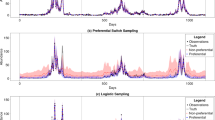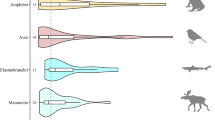Abstract
Residual demography is a recent concept that has proved to be a useful tool to gain insights about the age distributions of wild populations, especially insects. We develop an operator equation that permits the derivation of functionals of the age distribution in wild populations, such as mean age, within the framework of residual demography. Our method combines information from an observed captive cohort, which consists of subjects that are sampled from the wild with unknown ages and then raised in the laboratory until death, and from a reference cohort that consists of subjects raised in the laboratory since birth of the same population. Targeting functionals such as the mean of the wild age distribution has the advantage of avoiding strong assumptions such as stationarity and stability of the population that one would need when targeting the entire survival distribution in the wild. Our main result characterizes the existence of a solution of the operator equation that yields the functional of interest. The proposed method also enjoys straightforward and easy implementation. A data example is included illustrating an application, where one aims to attain the mean age of mosquitoes in the wild, based on seasonal captive cohorts from Greece and a simulated reference cohort, separately for various summer and fall months.


Similar content being viewed by others
References
Baker CR (1973) Joint measures and cross-covariance operators. Trans Am Math Soc 186:273–289
Carey JR, Müller HG, Wang JL, Papadopoulos NT, Diamantidis A, Koulousis NA (2012) Graphical and demographic synopsis of the captive cohort method for estimating population age structure in the wild. Exp Gerontol 47(10):787–791
Carey JR, Papadopoulos NT, Müller HG, Katsoyannos BI, Kouloussis NA, Wang JL, Wachter K, Yu W, Liedo P (2008) Age structure changes and extraordinary lifespan in wild medfly populations. Aging Cell 7(3):426–437
Conway JB (1985) A course in functional analysis. Springer, New York
Cox DR (1962) Renewal theory, vol 4. Methuen and Co, London
Feller W (2008) An introduction to probability theory and its applications, vol 2. Wiley, Hoboken
Goldstein JR (2009) Life lived equals life left in stationary populations. Demogr Res 20:3–6
Kato T (1995) Perturbation theory for linear operators. Springer, Berlin
Lo S, Mack Y, Wang J (1989) Density and hazard rate estimation for censored data via strong representation of the Kaplan–Meier estimator. Probab Theory Relat Fields 80(3):461–473
Lotka AJ (1939) A contribution to the theory of self-renewing aggregates, with special reference to industrial replacement. Ann Math Stat 10:1–25
Müller HG, Wang JL, Carey JR, Caswell-Chen EP, Chen C, Papadopoulos N, Yao F (2004) Demographic window to aging in the wild: constructing life tables and estimating survival functions from marked individuals of unknown age. Aging Cell 3(3):125–131
Müller HG, Wang JL, Yu W, Delaigle A, Carey JR (2007) Survival and aging in the wild via residual demography. Theor Popul Biol 72(4):513–522
Papadopoulos NT, Carey JR, Ioannou CS, Ji H, Müller HG, Wang JL, Luckhart S, Lewis EE (2016) Seasonality of Post-capture Longevity in a Medically-Important Mosquito (Culex pipiens). Front Ecol Evol 4:63
Preston SH, Heuveline P, Guillot M (2001) Demography: measuring and modeling population processes, vol 27. Blackwell Publishers, Malden
Rao ASS, Carey JR (2015) Generalization of Carey’s equality and a theorem on stationary population. J Math Biol 71(3):583–594
Silverman BW (1986) Density estimation for statistics and data analysis. Monographs on statistics and applied probability. Chapman & Hall, London
Vaupel JW (2009) Life lived and left: Carey’s equality. Demogr Res 20:7–10
Yang W, Müller H, Stadtmüller U (2011) Functional singular component analysis. J R Stat Soc Ser B (Stat Methodol) 73(3):303–324
Author information
Authors and Affiliations
Corresponding author
Additional information
Hans-Georg Müller: Research supported by NSF Grants DMS-1104426 and DMS-1407852.
Rights and permissions
About this article
Cite this article
Ji, H., Müller, HG., Papadopoulos, N.T. et al. Quantifying functionals of age distributions in the wild by solving an operator equation. J. Math. Biol. 75, 973–984 (2017). https://doi.org/10.1007/s00285-017-1105-x
Received:
Revised:
Published:
Issue Date:
DOI: https://doi.org/10.1007/s00285-017-1105-x
Keywords
- Aging in the wild
- Culex pipens
- Functional singular representation
- Existence of solution
- Inverse problem
- Operator equation
- Residual demography




